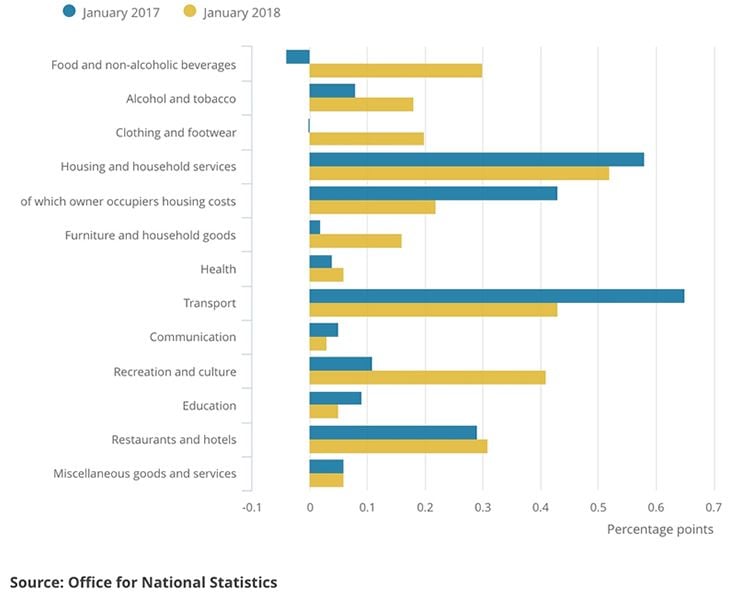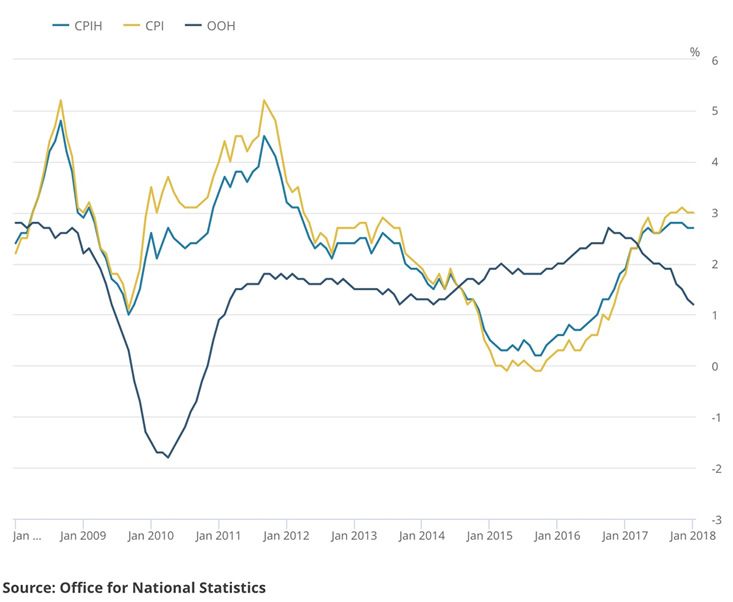The Pound is Higher on Data Showing UK Inflation is Running Hot

© photobuay, Adobe Stock
Pound Sterling firmed following the release of UK inflation data which confirms the Bank of England is right to show concern about rising prices.
The ONS reports annualised UK inflation for the month of January read at 3.0%, hotter than the 2.9% forecast by economists ahead of the release.
The largest downward contribution to change in the rate came from prices for motor fuels, which rose by less than they did a year ago.
The ONS report the main upward effect came from prices for a range of recreational and cultural goods and services, in particular, admissions to attractions such as zoos and gardens, for which prices fell by less than they did a year ago.
From a Pound Sterling perspective, the more important print is the core CPI figure which read at 2.7%, ahead of the 2.6% forecast by analysts.
Core CPI is indicative of domestically-generated prices and is what will interest policy makers at the Bank of England who believe their actions are able to target this component of the inflation mix. The main culprit identified by the ONS as being responsible for the "upward effect" appears to be exactly this kind of consumer-led inflation.
"My research shows that the subsequent market movement is most closely correlated to the core CPI measure," says Marshall Gittler at ACLS Global, "which makes sense as that’s the one that the Bank of England targets. In this case, it suggests that even though the headline figure might show slower inflation, the data is likely to be positive for the Pound."
The Pound showed an initial positive reaction to the data; but there has been little follow-through with the Pound-to-Dollar exchange rate seen at 1.3878, having opened the day at 1.3847.
The Pound-to-Euro exchange rate has steadily risen and being quoted at 1.1284 on the inter-bank market, having opened the day's account at 1.1257. Brexit issues will likely be the main concern for Sterling at this juncture we believe but the underlying economic fundamentals create conditions for a stronger currency.
Thus, were Brexit risks to recede, the prospect of a notably stronger Pound is likely.
Above: Sterling rises steadily against the Euro following the release of UK inflation data.
The unchanged 3% rate of inflation in January was in line with the Bank of England’s Inflation Report projection and confirms the Bank's view that consumer prices would remain stubbornly above their 2% target at the end of its two-to-three year forecast horizon.
Tuesday’s inflation numbers come just days after the Bank of England boosted Sterling after warned it will need to raise interest rates faster than previously thought if CPI remains stubbornly high and the story around it evolves in line with the Bank’s recent forecasts.
"We think that CPI inflation will end this year at around 2¼%. Somewhat counterintuitively, this may make it easier for the MPC to hike interest rates, as it helps to ease the squeeze on consumers’ real incomes," says Paul Hollingsworth, an economist with Capital Economics.
Analyst Phillip Shaw at Investec reckons the data in fact opens the door to three interest rate rises being delivered in the near-future. On inflation, Shaw says, "there is undoubtedly more to come," and "we stand by our forecasts that the MPC looks set to raise the Bank rate again by 25bps to 0.75% in May and subsequently to 1.0% in November. We expect a fourth hike in the cycle to 1.25% to follow in May next year."
This amount of interest rate rises is ahead of market expectation and if correct would therefore prove to be positive for Sterling.
The Bank sees much of the upward pressure on inflation during 2018 coming from a rise in oil prices, a gradual return to real income growth for households and a consequent dividend to the economy.
“Over the coming months, inflation is forecast to drift lower as the effects of the post-EU referendum decline in sterling starts to dissipate. However, we expect the decline to be gradual as rising domestic price pressures provide some offset,” says Rhys Herbert, an economist at Lloyds Banking Group.
However, the Bank of England’s forecasts for inflation and its declaration of intent on interest rates are highly contingent on a smooth and orderly path toward Brexit.
Many will know that tension recently returned to the negotiations, after a January long break, with London objecting to a series of Brussels’ demands related to the transition period while European negotiators insist that all demands must be met in order for a transition to be agreed.
A transition period ensures the status quo remains in place for a so-far unconfirmed period of time after March 2019. The government says it is necessary to ensure companies have enough time to prepare for any changes that will take place after the UK leaves the EU.
Negotiators have until the European Council summit of March 22 to agree a deal on transition if it is to be approved by national leaders from across the EU at the meeting.
Advertisement
Get up to 5% more foreign exchange by using a specialist provider to get closer to the real market rate and avoid the gaping spreads charged by your bank when providing currency. Learn more here.


